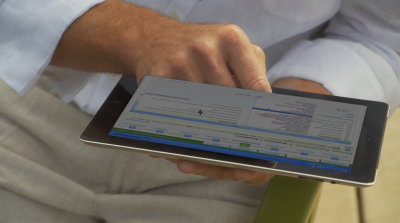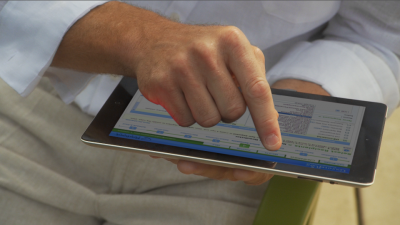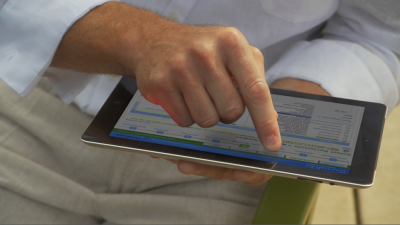Everyone loves the flashy visual effects you see in big budget movie productions, but there’s a whole class of visual effect shots that are actually designed to be completely invisible to the naked eye. These are the shots that you might take for granted as a viewer, but they really separate a good production from a great one. Here is an example of one of these effects from our recent work with NCR/Radiant Systems.
NCR/Radiant wanted to highlight their mobile point of sale and inventory management software, which meant getting a great shot of their program running on an iPad. Unfortunately, the screen of the iPad can be really tricky to get a great shot of due to glare and reflections on the screen. If we were just holding the tablet still, great lighting could solve this problem, but capturing mobile technology with a static shot is counter-intuitive, and besides, the shot called for us to bring in a 36 foot crane! In order to get the talent, the scene, and most importantly, the software to look great, we had to turn to a little post production magic.

The strange pink squares you see are tracking markers – aptly named since they help post production artists track an object’s motion through the shot. Using advanced software, we set about finding where the corners of the iPad would sit in each frame of the video, and virtually pinned the corners of our software screen shots to their place in the frame. Something about this process always reminds me of Wendy sewing Peter Pan’s shadow back on (maybe because the screen never seems to want to stick in place on the first try).
Even though the screen is digitally attached to the tracking markers, our work is just getting started. Look what happens when our actor reaches across the screen to interact with his device!

It’s not glamorous, and it’s not fun, but the only way to solve this problem is a tedious process called rotoscoping.
What that means is that someone goes through each frame of the video and traces the outline of our actor’s hand. It’s a lot like cutting a picture out of a magazine for a collage, except that there are 24 pictures to cut out for every second of the video, and even the tiniest mistake shows up when it starts to move. After hours and hours of doing this, we end up with this:

Much better. Now we at least have a picture that makes sense to our eyes. That said, there’s still a lot of work to do to really sell the illusion and make the effect truly invisible. First of all, that iPad has a glass screen, and glass is reflective. Not to mention, our hand isn’t casting a shadow now. The average person may not be able to tell you exactly what is wrong with the above image, but their intuition tell them that something about the shot feels wrong.
Luckily, we had some really good visual information left over from the original shot, and we could extract our reflections from that. Let’s take a closer look at our uncorrected shot to see what I mean.

If you want something to look realistic, you can’t do better than using the real thing. We ended up cutting out those reflections using a version of the technique we used to isolate the hand, then inserted them between our tracked screen and our rotoscoped hand. Here is the same shot, but with shadows and reflections added:

All of this work goes into creating an effect that, when done properly, no one in the audience will ever notice. This is why you want to work with a production company with a built in post production department. Even if you don’t think you want any flashy computer graphics or special effects, almost every shot can benefit from a little TLC in the edit. Details are make or break in video production.
You’ve probably seen invisible effects thousands of times in your life, and never even realized that anything had been done to the shot. This goes on all the time, and it’s one of the things that separates a good production company from a great one. We’ve used it to clean up dirty walls in the background, change the text on road signs, and even alter the packaging of a product in a shot.
Hopefully I’ve shown you something you didn’t expect from a visual effects artist, but before I leave you, I want to point out one more thing. There is still a problem with our composite. Can you see it?

